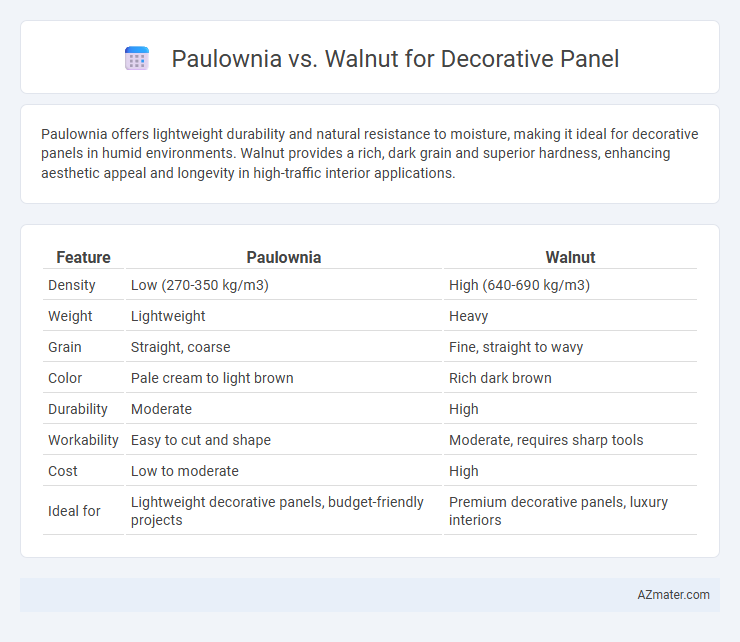Paulownia offers lightweight durability and natural resistance to moisture, making it ideal for decorative panels in humid environments. Walnut provides a rich, dark grain and superior hardness, enhancing aesthetic appeal and longevity in high-traffic interior applications.
Table of Comparison
| Feature | Paulownia | Walnut |
|---|---|---|
| Density | Low (270-350 kg/m3) | High (640-690 kg/m3) |
| Weight | Lightweight | Heavy |
| Grain | Straight, coarse | Fine, straight to wavy |
| Color | Pale cream to light brown | Rich dark brown |
| Durability | Moderate | High |
| Workability | Easy to cut and shape | Moderate, requires sharp tools |
| Cost | Low to moderate | High |
| Ideal for | Lightweight decorative panels, budget-friendly projects | Premium decorative panels, luxury interiors |
Introduction to Paulownia and Walnut Woods
Paulownia wood is lightweight, fast-growing, and highly resistant to warping, making it ideal for decorative panels that require easy handling and durability. Walnut wood is prized for its rich, dark color and fine grain, offering a luxurious, elegant aesthetic for high-end decorative paneling. Both woods present unique advantages in design, with Paulownia excelling in sustainability and Walnut valued for its classic beauty and strength.
Physical Characteristics Comparison
Paulownia wood is lightweight with a density around 0.32 g/cm3, making it easy to handle and ideal for large decorative panels, while walnut has a denser structure at approximately 0.6 to 0.7 g/cm3, offering greater durability and a richer texture. The fine, straight grain of Paulownia provides a smooth surface with minimal knots, contrasting walnut's more pronounced and varied grain patterns that enhance visual depth and warmth. Paulownia's softness facilitates easier cutting and shaping but sacrifices some scratch resistance compared to walnut's harder, more resilient surface suited for long-lasting decorative applications.
Grain Patterns and Aesthetics
Paulownia exhibits a light, uniform grain with subtle patterns that create a smooth, modern aesthetic ideal for minimalistic decorative panels. Walnut features rich, complex grain variations with deep chocolate and caramel tones, offering a luxurious and warm appearance perfect for statement wall panels and high-end interiors. The distinct grain intricacy of walnut often adds more visual depth and texture compared to the cleaner, more consistent look of paulownia.
Durability and Hardness
Paulownia wood is known for its lightweight properties but has lower durability and hardness, making it more prone to dents and wear in decorative panels. Walnut, on the other hand, offers superior hardness with a Janka hardness rating of approximately 1,010 lbf, providing enhanced resistance to impact and scratching. For decorative panels requiring long-term durability and toughness, walnut is the preferable choice due to its dense grain and strength.
Weight and Workability
Paulownia wood is significantly lighter than walnut, with a density around 300 kg/m3 compared to walnut's 640 kg/m3, making it easier to handle and install in decorative panels. Paulownia's soft texture allows for smooth cutting, shaping, and sanding, offering superior workability for intricate designs. Walnut, while heavier and denser, provides a rich grain and durability but requires more effort and specialized tools for detailed woodworking.
Finish and Staining Qualities
Paulownia offers a light, smooth grain that readily accepts stains, producing vibrant, even finishes ideal for decorative panels, while its softness requires careful sealing to avoid blotching. Walnut, prized for its rich, deep brown hues and natural grain patterns, provides a luxurious finish that enhances with stain and polish, yielding superior durability. Both woods respond well to finishing, but walnut's denser structure ensures more consistent stain absorption and a longer-lasting, refined appearance.
Environmental Impact and Sustainability
Paulownia wood is highly sustainable due to its rapid growth rate, ability to absorb carbon dioxide efficiently, and minimal resource requirements compared to walnut, which grows slower and demands more water and nutrients. Harvesting paulownia contributes less to deforestation and promotes carbon sequestration, whereas walnut, often sourced from slower-growing hardwood forests, may have a higher environmental footprint. Choosing paulownia for decorative panels aligns with eco-friendly practices by reducing habitat disruption and supporting renewable timber production.
Cost and Market Availability
Paulownia wood offers a cost-effective solution for decorative panels due to its rapid growth and abundance, typically priced lower than walnut. Walnut panels command a higher market price, attributed to their rich grain patterns and durability, making them a premium choice. Market availability favors paulownia in regions with fast-growing plantations, while walnut remains more limited due to slower growth and higher demand.
Common Applications in Decorative Panels
Paulownia wood is favored for decorative panels due to its lightweight nature and smooth grain, making it ideal for wall cladding, ceiling panels, and furniture accents that require easy handling and installation. Walnut, known for its rich dark tones and fine texture, is commonly used in high-end decorative panels for luxury interiors, cabinetry, and intricate inlays where visual appeal and durability are paramount. Both woods offer distinct aesthetic qualities; Paulownia suits modern, minimalist designs while Walnut enhances classic and sophisticated decor styles.
Choosing the Right Wood for Your Project
Paulownia offers lightweight properties and natural resistance to warping, making it ideal for decorative panels where ease of installation and dimensional stability are priorities. Walnut provides rich, dark tones with a tight grain structure, enhancing the visual appeal and luxury feel of high-end decorative applications. Selecting between Paulownia and Walnut depends on your project's emphasis on either weight and cost efficiency or premium aesthetics and durability.

Infographic: Paulownia vs Walnut for Decorative panel
 azmater.com
azmater.com